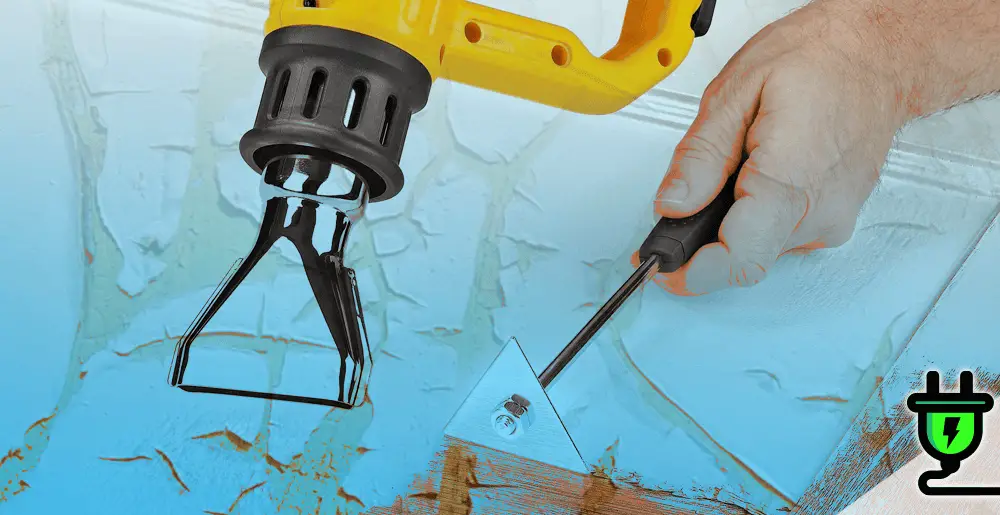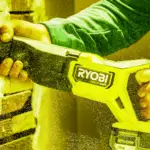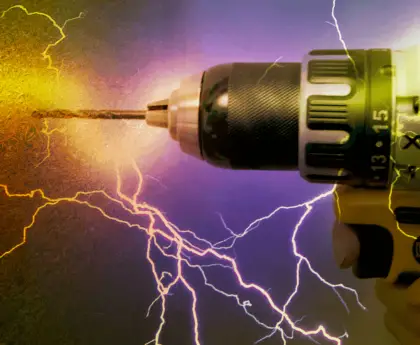The heat gun, a magical tool, removes stickers and shrinks wrap with gentle persuasion. It bends plastics, shapes thermoplastics, and thaws frozen locks. Wield it with care, for its power demands respect. But, heat gun to remove paint – you bet!
Yes, a heat gun can be used to remove paint. By carefully directing heat to the painted surface, the paint softens and can be scraped away. Caution is needed to avoid damaging the underlying surface.
So, if you are tired of old, peeling paint ruining the look of your favorite furniture or walls? Heat guns are a remarkable tool used to efficiently remove layers of paint from various surfaces.
In this guide, we will take you through why and how to use a heat gun for removing paint. Then we will get into comparing it with other methods and offering safe usage tips.
Stick around; let’s discover the power behind a heat gun together!
Why Use a Heat Gun to Remove Paint?
A heat gun is an effective tool for removing paint due to its effectiveness on different types of paint, efficiency in removing multiple layers, and versatility on various surfaces.
Effectiveness on different types of paint
Heat guns demonstrate a high degree of effectiveness on an array of paint types. Their impressive performance shines particularly with oil-based paints, including varieties like gloss.
The heat gun’s operation involves heating the paint to the optimal temperature for smooth scraping, typically around 400°C or 1000℉. Even though these devices excel on many substrates such as metal and wood, their usage is less effective and not recommended for plaster walls due to potential surface damage caused by extreme temperatures.
For those seeking alternatives with reduced fire risk, infrared paint strippers emerge as another viable option in certain scenarios. Despite these limitations, heat guns maintain their position as powerful tools for removing different types of paints across multiple surfaces effectively.
Efficiency in removing multiple layers
Heat guns are highly efficient when it comes to removing multiple layers of paint. The high temperatures produced by the heat gun soften the paint, making it easier to scrape off. This means that you can strip away several layers of paint in less time compared to other methods like sanding or using a chemical remover.
By heating the paint and then gently scraping it away, you can achieve a smooth and clean surface without much hassle. Heat guns are especially effective for removing oil-based paints and stubborn coatings, saving you time and effort in your paint removal projects.
Versatility on various surfaces
Heat guns are incredibly versatile when it comes to removing paint as they can be used on a variety of surfaces. Whether you need to strip paint from wood, metal, or even plastic, a heat gun can get the job done.
Its high temperatures effectively soften the paint, making it easier to scrape off without damaging the underlying surface. So no matter what type of project you have in mind, a heat gun is a reliable tool that will help you achieve efficient and effective results.
Heat Gun vs Other Paint Removal Methods
The heat gun is a superior option for paint removal compared to other methods like chemical paint removers, sanding, planers, and infrared paint strippers.
Chemical paint remover
Chemical paint remover is another method commonly used to strip paint. It involves applying a chemical solution to the painted surface, which breaks down the bond between the paint and the substrate, making it easier to remove.
One popular example of a chemical paint remover is Citristrip, which is made from natural citrus ingredients. This type of paint remover can be effective in removing multiple layers of paint and is often used for intricate or delicate surfaces where other methods may not be suitable.
However, it’s important to follow safety precautions when using chemical paint removers and to choose products that are safe for use on specific surfaces like wood or metal.
Sanding
Sanding is a commonly used method for removing paint from surfaces. It involves using sandpaper or a sanding block to manually scrape away the layers of paint. Sanding can be effective in situations where heat guns or chemical paint removers may not be suitable, such as on delicate surfaces or when dealing with lead-based paints.
However, sanding can be time-consuming and labor-intensive, especially if there are multiple layers of paint to remove. Additionally, it can create a lot of dust, so it’s important to wear protective gear like goggles and masks while sanding.
Regularly changing the sandpaper grit level helps achieve smoother results during the process.
Planer
A planer is another paint removal method to consider. This tool works well for flat surfaces, like wooden floors or tabletops. By shaving off thin layers of paint, a planer can effectively remove multiple coats of paint in one pass.
It’s a quicker option compared to using a heat gun or chemical removers, especially for larger projects. However, caution must be taken as the planer can potentially damage the surface if not used properly.
Always follow safety guidelines and use gentle pressure when operating the planer to avoid any mishaps during the paint stripping process.
Infrared paint stripper
Infrared paint strippers are an alternative to heat guns for removing paint. They use infrared technology to generate high temperatures that soften the paint, making it easier to scrape off.
The advantage of infrared paint strippers is their reduced fire risk compared to heat guns. By heating the paint without direct contact, there is less chance of igniting flammable materials like wood or solvents used in the paint.
Infrared paint strippers are a safe and effective option for those looking to remove paint from various surfaces.
Choosing the Right Heat Gun for Paint Stripping
When selecting a heat gun for paint stripping, it is important to consider factors such as temperature control, wattage, and nozzle attachments.
Factors to consider
Using a heat gun to remove paint requires several factors to consider. First, you’ll want to consider the temperature range of the heat gun. Look for a model that can reach high temperatures, around 400°C/1000℉, as this is necessary for effectively softening and removing paint.
Additionally, it’s important to choose a heat gun with adjustable settings so you can control the intensity of the heat. This will allow you to tailor the tool to different types of paint and surfaces.
Lastly, consider the size and weight of the heat gun. Opt for a lightweight model with an ergonomic design that will be comfortable to hold for extended periods.
When selecting a heat gun for paint removal, it’s also worth considering additional features such as safety controls and attachments or nozzles that can enhance its versatility. Look for models with built-in safety measures like overheat protection or automatic shutoff functions to ensure safe operation.
Recommendations for the best heat guns
For the best heat guns for paint removal, consider models with adjustable temperature settings and multiple fan speeds. Look for a heat gun that has a durable construction and ergonomic grip for comfortable use.
It is important to choose a heat gun with safety features like overheating protection and a built-in stand or holster. Additionally, selecting a model with interchangeable nozzles can provide versatility for different paint stripping tasks.
Be sure to read customer reviews and check the warranty before making your final decision on the best heat gun to remove paint.
How to Safely Remove Paint with a Heat Gun
To safely remove paint with a heat gun, it is important to take certain precautions. Begin by wearing protective gear such as safety goggles, gloves, and a mask to prevent any potential harm from fumes or debris.
Next, ensure proper ventilation in the workspace by opening windows or using fans. When operating the heat gun, always keep it moving and maintain a safe distance of 6-8 inches from the painted surface to avoid scorching or burning the material underneath.
Use a metal scraper to gently scrape off softened paint while being careful not to damage the surface. Finally, after removing all paint layers, allow ample time for cooling before applying any new finish or coating.
Safety considerations
Safety is of utmost importance when using a heat gun to remove paint. The high temperatures produced by the heat gun can pose risks if not handled properly. It is essential to wear protective gear, such as gloves and safety glasses, to prevent burns or eye injuries.
Adequate ventilation is also crucial to avoid inhalation of fumes or smoke that may be released during the paint removal process. Additionally, it’s important to be cautious while working around flammable materials and ensure there are no open flames nearby.
Lastly, take care when handling the heated metal scraper, as it can become hot and cause burns. By following safety precautions, you can safely remove paint with a heat gun and minimize potential hazards.
Steps for using a heat gun to remove paint
To safely and effectively remove paint using a heat gun, follow these simple steps. First, ensure you have the proper safety gear, including gloves and goggles. Next, plug in the heat gun and set it to the desired temperature based on the type of paint you are removing.
Hold the heat gun about six inches away from the painted surface and move it back and forth in a slow and steady motion. As the paint begins to bubble or soften, use a metal scraper to gently scrape away the loosened paint.
Continue heating small sections at a time and scraping until all of the paint is removed. Remember to always work in well-ventilated areas due to fumes that may be released during this process.
Heat Gun To Remove Paint FAQs
Can a heat gun be used to remove paint?
Yes, a heat gun can be used to effectively remove paint from surfaces by softening it with the high temperature and then scraping it away.
What safety precautions should I take when using a heat gun for paint removal?
When using a heat gun, it is important to wear protective gloves and eyewear to prevent burns or eye injuries. Ensure proper ventilation in the area to avoid inhaling fumes. Also, keep flammable materials away from the work area.
How do I use a heat gun to remove paint?
To use a heat gun for paint removal, hold the unit about 2-4 inches away from the painted surface and move it back and forth across the area until the paint begins to bubble or blister. Then, carefully scrape off the softened paint using a putty knife or scraper.
Are there any surfaces that should not be treated with a heat gun for paint removal?
Not all surfaces are suitable for using a heat gun for paint removal. Heat guns should not be used on delicate materials such as plastic or vinyl as they can warp or melt under high temperatures. It is always recommended to test on an inconspicuous area first before treating larger surfaces.
Conclusion
Using a heat gun for paint removal offers numerous benefits. It is effective in removing different types of paint, efficient in removing multiple layers, and versatile on various surfaces.
While there are other methods available, such as chemical paint removers or sanding, the heat gun proves to be a superior choice. With the proper safety precautions and technique, the heat gun can make your paint stripping projects easier and more successful.






